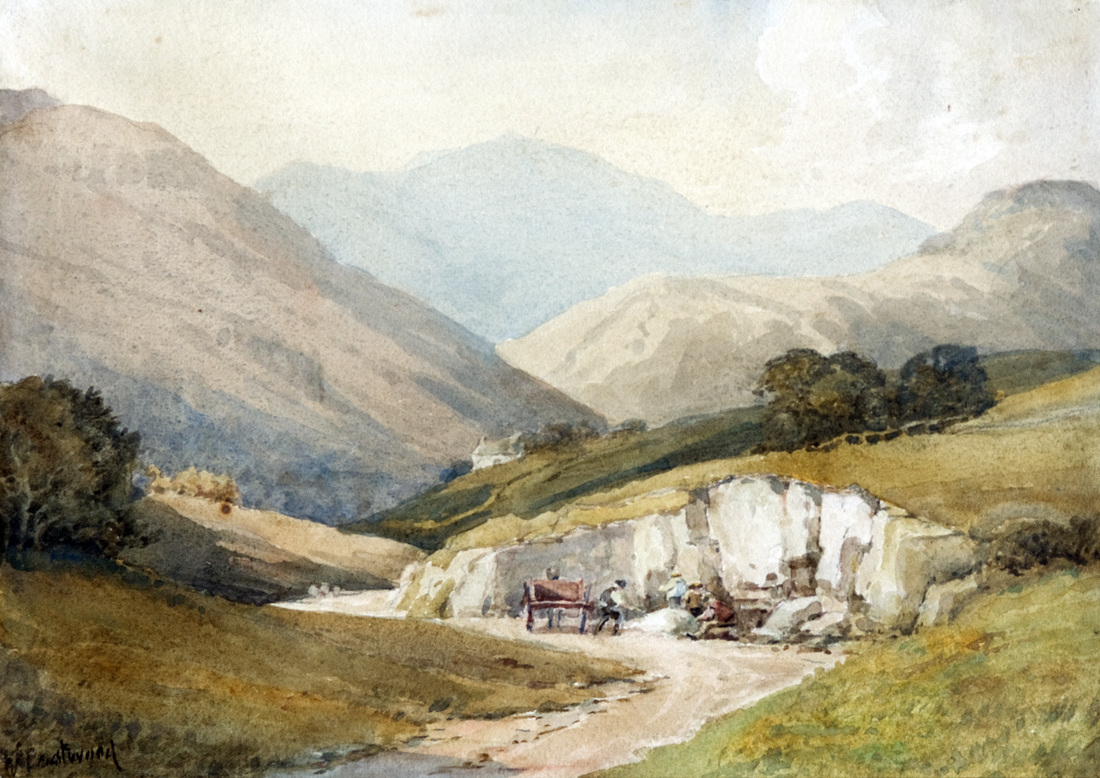The Roadmenders' Quarry
|
Research by Sue Cannon
|
|
Acc No 244
Artist Walter Eastwood Artist dates 1867-1943 Medium watercolour Size unknown Date Exhib.1925 Donor Gillian Clay, b.1966 Beowolf Covert, Stretton, Burton on Trent Date donated 12 August 2013 Walter Eastwood biography by Lytham Heritage Group |
Roadmenders’ Quarry, painted by British landscape artist Walter Eastwood, is quintessentially a fine example of an English watercolour painting depicting a deep spatial landscape surrounded in the distance by hills, possibly in the Lake District. We are led into the composition by the unmade road of hard ground set in this grassy, seemingly isolated landscape. The land rises away from the road on either side, gently on the left of picture and more severely on the right side, leading us to the focal point, which is a small white quarry cut into the hillside where a number of men seem to be working, breaking up stone. There is a horse and cart which will carry the heavy stone away. The men appear unaware of the viewer as they are involved with the work. The road, which takes us into and round the middle ground of the picture and out of sight into the hills beyond, forms a horizontal flat shape creating space and movement in the shallow foreground. The rough hillside grassland, which cuts across the viewer’s vision from the bottom of the painting at the start of the road towards the right side of the picture and rises to surround the quarry face and enclose it, is bathed in a yellow ochre light contrasting to the deep green shadows on the trees and hillside in the middle ground on both sides of the image. The deep shadows give and emphasise both a weight and space, highlighting the softer light of the foreground and the whiteness of the quarry stone.
Rhythm and movement comes from the wandering line of the foreground grass line which moves up and round the top of the quarry, gently outlined so expressing space and height to the scene. The rhythm of the short curving road also moves the viewer’s eye in and around the composition leading to the dynamic pale blue and soft browns of the distant hills, rising to a great height within the scene, towering above us, and the scene below of the roadmenders at work. The dark green tree on the left of the centre composition is mirrored in colour and balanced by a cluster of small trees which hold the eye within the painted scene guiding us to the distant background hills.
Nestling almost out of sight we see the grey roof of a small white cottage protected by more trees in this almost barren terrain. The cottage looks tiny within this scene and isolated until our eye is drawn to the lighter hill on the left middle ground where we notice another possible farmhouse halfway up the hill. The two cottages and the deep dark green shadows express a deep space beyond. This quiet, tranquil countryside scene, with the possible tapping of the roadmenders’ hammers, captures the mellow warmth of the English countryside on a summer afternoon, capturing a moment in time.
Rhythm and movement comes from the wandering line of the foreground grass line which moves up and round the top of the quarry, gently outlined so expressing space and height to the scene. The rhythm of the short curving road also moves the viewer’s eye in and around the composition leading to the dynamic pale blue and soft browns of the distant hills, rising to a great height within the scene, towering above us, and the scene below of the roadmenders at work. The dark green tree on the left of the centre composition is mirrored in colour and balanced by a cluster of small trees which hold the eye within the painted scene guiding us to the distant background hills.
Nestling almost out of sight we see the grey roof of a small white cottage protected by more trees in this almost barren terrain. The cottage looks tiny within this scene and isolated until our eye is drawn to the lighter hill on the left middle ground where we notice another possible farmhouse halfway up the hill. The two cottages and the deep dark green shadows express a deep space beyond. This quiet, tranquil countryside scene, with the possible tapping of the roadmenders’ hammers, captures the mellow warmth of the English countryside on a summer afternoon, capturing a moment in time.

